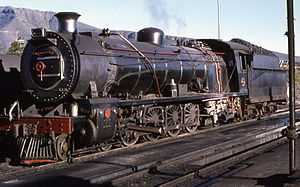South African Class 15A 4-8-2
| South African Class 15A 4-8-2 & South African Class 15AR 4-8-2 | |
|---|---|
|
Class 15AR no. 1788 at Graaff Reinet, 4 April 1978 | |
| Type and origin | |
| Power type | Steam |
| Designer | South African Railways |
| Builder |
North British Locomotive Company Beyer, Peacock and Company J.A. Maffei |
| Serial number |
NBL 20556-20560, 20843-20850, 21054-21063, 21436-21441, 21502-21505, 21718-21737, 22736-22750 [1] BP 5955-5974, 5978-5987 [2] Maffei 5625-5645 [3] |
| Model | Class 15A |
| Build date | 1914-1925 |
| Total produced | 119 |
| Specifications | |
| Configuration | 4-8-2 "Mountain" |
| Gauge | 3 ft 6 in (1,067 mm) Cape gauge |
| Leading wheel diameter | 28.5 in (724 mm) |
| Driver diameter | 57 in (1,450 mm) |
| Trailing wheel diameter | 33 in (838 mm) |
| Wheelbase |
Engine: 6 ft 2 in (1.880 m) bogie 15 ft (4.572 m) coupled 33 ft 8 in (10.262 m) total Tender: 6 ft 2 in (1.880 m) bogie 20 ft 5 in (6.223 m) total Total: 63 ft 6.875 in (19.377 m) |
| Length | 71 ft 6.5 in (21.806 m) |
| Height |
12 ft 10 in (3.912 m) as built 12 ft 11.75 in (3.956 m) reboilered |
| Frame | Plate frame |
| Axle load |
16.55 long tons (16.8 t) on 3rd driver as built 16.55 long tons (16.8 t) on 3rd driver reboilered, steel firebox 16.7 long tons (17.0 t) on 3rd driver reboilered, copper firebox |
| Weight on drivers |
66 long tons (67.1 t) as built 65.95 long tons (67.0 t) reboilered, steel firebox 66.2 long tons (67.3 t) reboilered, copper firebox |
| Locomotive weight |
94.8 long tons (96.3 t) as built 94.3 long tons (95.8 t) reboilered, steel firebox 94.85 long tons (96.4 t) reboilered, copper firebox |
| Tender weight |
61,520 lb (27.9 t) empty 66 long tons (67.1 t) w/o |
| Locomotive and tender combined weight |
185,920 lb (84.3 t) empty 160 long tons (162.6 t) w/o as built 160.3 long tons (162.9 t) w/o, steel firebox 160.85 long tons (163.4 t) w/o, copper firebox |
| Tender type |
MT - MP, MP1, MR, MS, MT, MT1, MT2, MX, MY, MY1 permitted * 2 axle bogies * 34 in (864 mm) wheels * Length 28 ft 5.375 in (8.671 m) |
| Fuel type | Coal |
| Fuel capacity | 12 long tons (12.2 t) |
| Water capacity | 6,000 imp gal (27,000 l) |
| Boiler |
As built: 5 ft 4.625 in (1.641 m) inside diameter 19 ft (5.791 m) inside length 7 ft 9 in (2.362 m) pitch Reboilered: 5 ft 7.5 in (1.715 m) inside diameter 21 ft 8 in (6.604 m) inside length, steel firebox 21 ft 7.625 in (6.594 m) inside length, copper firebox 8 ft 0.5 in (2.451 m) pitch |
| Boiler pressure |
185 psi (1,280 kPa) as built 190 psi (1,310 kPa) reboilered |
| Firegrate area |
40 sq ft (3.716 m2) as built 37 sq ft (3.437 m2) reboilered |
| Heating surface: – Tubes |
As built: 113 tubes 2.25 in (57.1 mm) diameter 21 tubes 5.5 in (140 mm) diameter 1,934 sq ft (179.674 m2) Reboilered: 87 tubes 2.5 in (63.5 mm) diameter 30 tubes 5.5 in (140 mm) diameter 2,171 sq ft (201.692 m2) |
| – Firebox |
192 sq ft (17.837 m2) as built 142 sq ft (13.192 m2) reboilered |
| – Total |
2,026 sq ft (188.222 m2) as built 2,313 sq ft (214.885 m2) reboilered |
| Superheater area |
476 sq ft (44.222 m2) as built 537 sq ft (49.889 m2) reboilered |
| Cylinders | Two |
| Cylinder size |
22 in (559 mm) bore 28 in (711 mm) stroke |
| Valve gear | Walschaerts |
| Performance figures | |
| Tractive effort |
At 75% boiler pressure: 32,990 lbf (146.7 kN) as built 33,880 lbf (150.7 kN) reboilered [4] |
| Career | |
| Operator(s) |
South African Railways Swaziland Railway |
| Class | Class 15A, Class 15AR |
| Number in class | 119 |
| Number(s) | 1571-1575, 1781-1828, 1839-1858, 1961-1970, 2011-2025, 2080-2100 |
| Delivered | 1914-1925 |
| First run | 1914 |
The South African Class 15A 4-8-2 of 1914 is a South African steam locomotive from the South African Railways era.
Between 1914 and 1925 the South African Railways placed one hundred and nineteen Class 15A steam locomotives with a 4-8-2 Mountain type wheel arrangement in service, delivered in ten batches from three manufacturers.[3][5]
Manufacturers
The Class 15 and Class 15A were the final development of the plate framed 4-8-2 Mountain locomotive designed by D.A. Hendrie, Chief Mechanical Engineer (CME) of the South African Railways (SAR) from 1910 to 1922. Of the whole Hendrie Mountain family, the Class 15A proved to be his most useful and most numerous group of locomotives.[3][6]
The predecessor Class 15 locomotives had one flaw, excessively long firetubes. When more were ordered, Hendrie improved the boiler by adding a combustion chamber and shortening the distance between tube plates from 21 feet 9 inches (6.629 metres) to 19 feet (5.791 metres) in the process. These locomotives were designated Class 15A and were built in ten batches by three manufacturers. Being wartime, initial production and delivery occurred in dribs and drabs.[3]
- Five were delivered by the North British Locomotive Company (NBL) in 1914, numbered in the range from 1571 to 1575.
- Eight more were delivered by NBL, also in 1914, numbered in the range from 1781 to 1788. Like the Class 15, these first thirteen locomotives had narrow cabs, rear end running boards that curved down below their cabs and Belpaire fireboxes, but unlike the Class 15, with a combustion chamber.
- Ten more were delivered by NBL in 1915, numbered in the range from 1789 to 1798. While the first two batches were delivered with all coupled wheels flanged, beginning with this third batch the leading coupled wheels were flangeless to cope with the sharp curves on the Hex River Pass. These and subsequent locomotives also had rear end running boards continuing straight through underneath their cabs.[3]
- Six more were delivered by NBL in 1916, numbered in the range from 1799 to 1804.
- Four more were delivered by NBL in 1917, numbered in the range from 1805 to 1808.
- Twenty more were delivered by NBL in 1920, numbered in the range from 1809 to 1828. These twenty and all subsequent Class 15A locomotives were delivered with wider cabs.
- Twenty were delivered by Beyer, Peacock and Company in 1920, numbered in the range from 1839 to 1858.
- Ten more were delivered by Beyer, Peacock in 1921, numbered in the range from 1961 to 1970.
- Fifteen were delivered by NBL in 1921, numbered in the range from 2011 to 2025.
- Twenty-one were delivered by J.A. Maffei in 1925, numbered in the range from 2080 to 2100.[3][6]
Valve gear experiment
The last Class 15A locomotive, Maffei built number 2100, was fitted with Lentz Rotary Cam Poppet valve gear as an experiment, but this was soon replaced with Walschaerts valve gear and piston-valve cylinders, thereby turning number 2100 into a standard Class 15A.[3][6]
Watson Standard boilers
During the 1930s many serving locomotives were reboilered with a standard boiler type designed by A.G. Watson, CME of the SAR from 1929 to 1936, as part of his standardisation policy. Such Watson Standard reboilered locomotives were reclassified by adding an "R" suffix to their classification.[4][5]
When Class 15A locomotives were reboilered with Watson Standard no. 2A boilers, they were therefore reclassified to Class 15AR. Early conversions were equipped with copper and later conversions with steel fireboxes. In the process they were also equipped with Watson cabs, with their distinctive slanted fronts compared to the conventional vertical fronts of their original cabs.[4]
Since the only difference between the as-delivered Class 15 and Class 15A lay in the length of their boilers, Class 15 locomotives that were reboilered with Watson Standard boilers were also reclassified to Class 15AR.[5]
An obvious visual difference between an original and a Watson Standard reboilered locomotive is usually a rectangular regulator cover just to the rear of the chimney on the reboilered locomotive. In the case of the Class 15A and Class 15AR two even more obvious visual differences are the Watson cab and the absence of the Belpaire firebox hump between the cab and boiler on the reboilered locomotives. In addition, during reboilering the early Class 15A models with curved down rear end running boards and narrow cabs were altered to straight rear end running boards with wider cabs.[4]
The table lists the Class 15A engine numbers, builders, years built, works numbers and eventual classifications.[4]
| SAR No. |
Builder |
Year |
Works No. |
Class |
|---|---|---|---|---|
| 1571 | NBL | 1914 | 20556 | 15AR |
| 1572 | NBL | 1914 | 20557 | 15AR |
| 1573 | NBL | 1914 | 20558 | 15AR |
| 1574 | NBL | 1914 | 20559 | 15AR |
| 1575 | NBL | 1914 | 20560 | 15AR |
| 1781 | NBL | 1914 | 20843 | 15AR |
| 1782 | NBL | 1914 | 20844 | 15AR |
| 1783 | NBL | 1914 | 20845 | 15AR |
| 1784 | NBL | 1914 | 20846 | 15AR |
| 1785 | NBL | 1914 | 20847 | 15AR |
| 1786 | NBL | 1914 | 20848 | 15AR |
| 1787 | NBL | 1914 | 20849 | 15AR |
| 1788 | NBL | 1914 | 20850 | 15AR |
| 1789 | NBL | 1915 | 21054 | 15AR |
| 1790 | NBL | 1915 | 21055 | 15AR |
| 1791 | NBL | 1915 | 21056 | 15A |
| 1792 | NBL | 1915 | 21057 | 15AR |
| 1793 | NBL | 1915 | 21058 | 15AR |
| 1794 | NBL | 1915 | 21059 | 15AR |
| 1795 | NBL | 1915 | 21060 | 15AR |
| 1796 | NBL | 1915 | 21061 | 15AR |
| 1797 | NBL | 1915 | 21062 | 15AR |
| 1798 | NBL | 1915 | 21063 | 15AR |
| 1799 | NBL | 1916 | 21436 | 15AR |
| 1800 | NBL | 1916 | 21437 | 15AR |
| 1801 | NBL | 1916 | 21438 | 15AR |
| 1802 | NBL | 1916 | 21439 | 15AR |
| 1803 | NBL | 1916 | 21440 | 15AR |
| 1804 | NBL | 1916 | 21441 | 15AR |
| 1805 | NBL | 1917 | 21502 | 15AR |
| 1806 | NBL | 1917 | 21503 | 15AR |
| 1807 | NBL | 1917 | 21504 | 15AR |
| 1808 | NBL | 1917 | 21505 | 15AR |
| 1809 | NBL | 1919 | 21718 | 15AR |
| 1810 | NBL | 1919 | 21719 | 15AR |
| 1811 | NBL | 1919 | 21720 | 15AR |
| 1812 | NBL | 1919 | 21721 | 15AR |
| 1813 | NBL | 1919 | 21722 | 15AR |
| 1814 | NBL | 1919 | 21723 | 15AR |
| 1815 | NBL | 1919 | 21724 | 15AR |
| 1816 | NBL | 1919 | 21725 | 15AR |
| 1817 | NBL | 1919 | 21726 | 15AR |
| 1818 | NBL | 1919 | 21727 | 15AR |
| 1819 | NBL | 1919 | 21728 | 15AR |
| 1820 | NBL | 1919 | 21729 | 15AR |
| 1821 | NBL | 1919 | 21730 | 15AR |
| 1822 | NBL | 1919 | 21731 | 15AR |
| 1823 | NBL | 1919 | 21732 | 15AR |
| 1824 | NBL | 1919 | 21733 | 15A |
| 1825 | NBL | 1919 | 21734 | 15AR |
| 1826 | NBL | 1919 | 21735 | 15AR |
| 1827 | NBL | 1919 | 21736 | 15AR |
| 1828 | NBL | 1919 | 21737 | 15AR |
| 1839 | BP | 1920 | 5955 | 15AR |
| 1840 | BP | 1920 | 5956 | 15AR |
| 1841 | BP | 1920 | 5957 | 15AR |
| 1842 | BP | 1920 | 5958 | 15AR |
| 1843 | BP | 1920 | 5959 | 15AR |
| 1844 | BP | 1920 | 5960 | 15AR |
| 1845 | BP | 1920 | 5961 | 15A |
| 1846 | BP | 1920 | 5962 | 15AR |
| 1847 | BP | 1920 | 5963 | 15AR |
| 1848 | BP | 1920 | 5964 | 15AR |
| 1849 | BP | 1920 | 5965 | 15AR |
| 1850 | BP | 1920 | 5966 | 15AR |
| 1851 | BP | 1920 | 5967 | 15A |
| 1852 | BP | 1920 | 5968 | 15AR |
| 1853 | BP | 1920 | 5969 | 15AR |
| 1854 | BP | 1920 | 5970 | 15AR |
| 1855 | BP | 1920 | 5971 | 15AR |
| 1856 | BP | 1920 | 5972 | 15AR |
| 1857 | BP | 1920 | 5973 | 15AR |
| 1858 | BP | 1920 | 5974 | 15AR |
| 1961 | BP | 1921 | 5978 | 15AR |
| 1962 | BP | 1921 | 5979 | 15AR |
| 1963 | BP | 1921 | 5980 | 15AR |
| 1964 | BP | 1921 | 5981 | 15AR |
| 1965 | BP | 1921 | 5982 | 15AR |
| 1966 | BP | 1921 | 5983 | 15AR |
| 1967 | BP | 1921 | 5984 | 15AR |
| 1968 | BP | 1921 | 5985 | 15AR |
| 1969 | BP | 1921 | 5986 | 15AR |
| 1970 | BP | 1921 | 5987 | 15A |
| 2011 | NBL | 1921 | 22736 | 15AR |
| 2012 | NBL | 1921 | 22737 | 15AR |
| 2013 | NBL | 1921 | 22738 | 15AR |
| 2014 | NBL | 1921 | 22739 | 15AR |
| 2015 | NBL | 1921 | 22740 | 15AR |
| 2016 | NBL | 1921 | 22741 | 15AR |
| 2017 | NBL | 1921 | 22742 | 15AR |
| 2018 | NBL | 1921 | 22743 | 15AR |
| 2019 | NBL | 1921 | 22744 | 15AR |
| 2020 | NBL | 1921 | 22745 | 15AR |
| 2021 | NBL | 1921 | 22746 | 15AR |
| 2022 | NBL | 1921 | 22747 | 15AR |
| 2023 | NBL | 1921 | 22748 | 15AR |
| 2024 | NBL | 1921 | 22749 | 15AR |
| 2025 | NBL | 1921 | 22750 | 15AR |
| 2080 | Maffei | 1925 | 5625 | 15AR |
| 2081 | Maffei | 1925 | 5626 | 15AR |
| 2082 | Maffei | 1925 | 5627 | 15AR |
| 2083 | Maffei | 1925 | 5628 | 15AR |
| 2084 | Maffei | 1925 | 5629 | 15AR |
| 2085 | Maffei | 1925 | 5630 | 15AR |
| 2086 | Maffei | 1925 | 5631 | 15AR |
| 2087 | Maffei | 1925 | 5632 | 15AR |
| 2088 | Maffei | 1925 | 5633 | 15AR |
| 2089 | Maffei | 1925 | 5634 | 15AR |
| 2090 | Maffei | 1925 | 5635 | 15AR |
| 2091 | Maffei | 1925 | 5636 | 15AR |
| 2092 | Maffei | 1925 | 5637 | 15AR |
| 2093 | Maffei | 1925 | 5638 | 15AR |
| 2094 | Maffei | 1925 | 5639 | 15AR |
| 2095 | Maffei | 1925 | 5640 | 15AR |
| 2096 | Maffei | 1925 | 5641 | 15AR |
| 2097 | Maffei | 1925 | 5642 | 15AR |
| 2098 | Maffei | 1925 | 5643 | 15AR |
| 2099 | Maffei | 1925 | 5644 | 15AR |
| 2100 | Maffei | 1925 | 5645 | 15AR |
Service
The Class 15A, one of the best classes of mainline mixed traffic locomotives to see service in South Africa, was placed in service on the Cape mainline to Kimberley, where they formed the mainstay of motive power for many years. They ended up working in all parts of the country and proved to be reliable, free-steaming locomotives that ran up high mileage figures between major overhauls.[3]
As the reboilered Class 15AR, many ended up working in the Eastern Transvaal around Waterval Boven, in the Western Transvaal, Eastern Cape and the Orange Free State. During the 1960s many were transferred to the Cape Midland and used mainly on the section from Port Elizabeth to Klipplaat and in passenger service on the Uitenhage suburban.[5]
Near the end of their service lives in the early 1980s, they were all relegated to shunting work at centres all around the country, except for some that were hired out to Swaziland and that were still employed in mainline service on the Swaziland Railway, until they were eventually replaced by diesel traction and retired.[6]
Modifications illustrated
The main picture shows reboilered NBL 1914-built Class 15A no. 1788 at Graaff Reinet on 4 April 1978. Differences between the various locomotive models are illustrated in the pictures below.
- Locomotives as built, with Belpaire fireboxes.
-
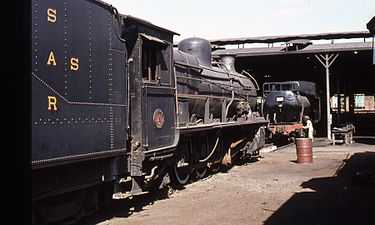
Class 15A no. 1791 (NBL 1915 narrow cab) at Capital Park, 23 March 1978
-
.jpg)
Class 15A no. 1823 (NBL 1919 wide cab) at Paardeneiland, circa 1930
-
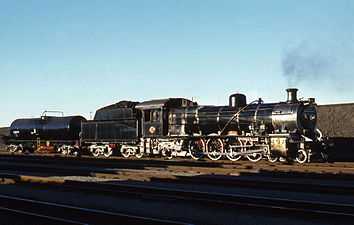
Class 15A no. 1970 "Milly" (BP 1921 wide cab) at De Aar, 13 April 1979
- Ex narrow cab Class 15AR locomotives, reboilered with Watson Standard no. 2A boilers.
-
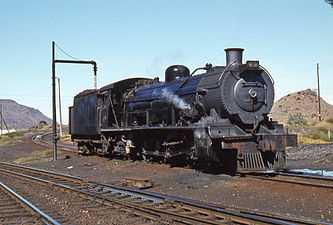
No. 1575 (NBL 1914) at Rosmead, Cape Province, 21 April 1979
-
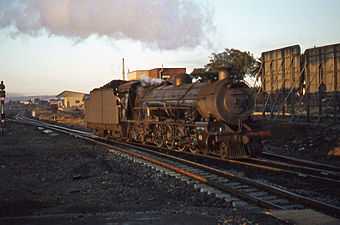
No. 1804 (NBL 1916) at New Brighton, Port Elizabeth, 16 April 1979
-
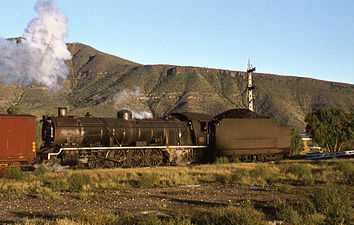
No. 1805 (NBL 1917) at Graaff Reinet, Cape Province, 4 April 1978
- Ex wide cab Class 15AR locomotives, reboilered with Watson Standard no. 2A boilers.
-

No. 1811 (NBL 1919) at Sydenham, Port Elizabeth, 30 March 1979
-
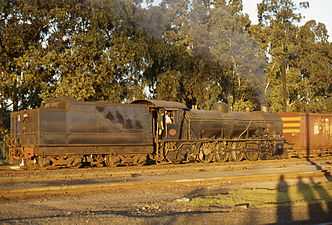
No. 1855 (BP 1920) at Klipplaat, Cape Province, 16 April 1979
-
No. 2100 (Maffei 1925), the last Class 15A, at Queenstown, 26 April 2013
See also
- List of South African locomotive classes
- South African Class 15 4-8-2
- South African Class 15B 4-8-2
- South African Class 15C 4-8-2
- South African Class 15CA 4-8-2
- South African Class 15E 4-8-2
- South African Class 15F 4-8-2
- South African locomotive history
- Tender locomotive numbering and classification
- The 4-8-2 "Mountain"
- Watson Standard boilers
References
|
- ↑ North British Locomotive Company works list, compiled by Austrian locomotive historian Bernhard Schmeiser
- ↑ Beyer, Peacock and Company production list, excluding Garratts, Customer List V1 04.08.02
- ↑ 3.0 3.1 3.2 3.3 3.4 3.5 3.6 3.7 Holland, D.F. (1972). Steam Locomotives of the South African Railways, Volume 2: 1910-1955 (1st ed.). Newton Abbott, Devon: David & Charles. pp. 26–27. ISBN 978-0-7153-5427-8.
- ↑ 4.0 4.1 4.2 4.3 4.4 South African Railways and Harbours Locomotive Diagram Book, 2’0” & 3’6” Gauge Steam Locomotives, 15 August 1941, as amended
- ↑ 5.0 5.1 5.2 5.3 Paxton, Leith; Bourne, David (1985). Locomotives of the South African Railways (1st ed.). Cape Town: Struik. pp. 10–11, 60. ISBN 0869772112.
- ↑ 6.0 6.1 6.2 6.3 Durrant, A E (1989). Twilight of South African Steam (1st ed.). Newton Abbott, London: David & Charles. pp. 83–84. ISBN 0715386387.
